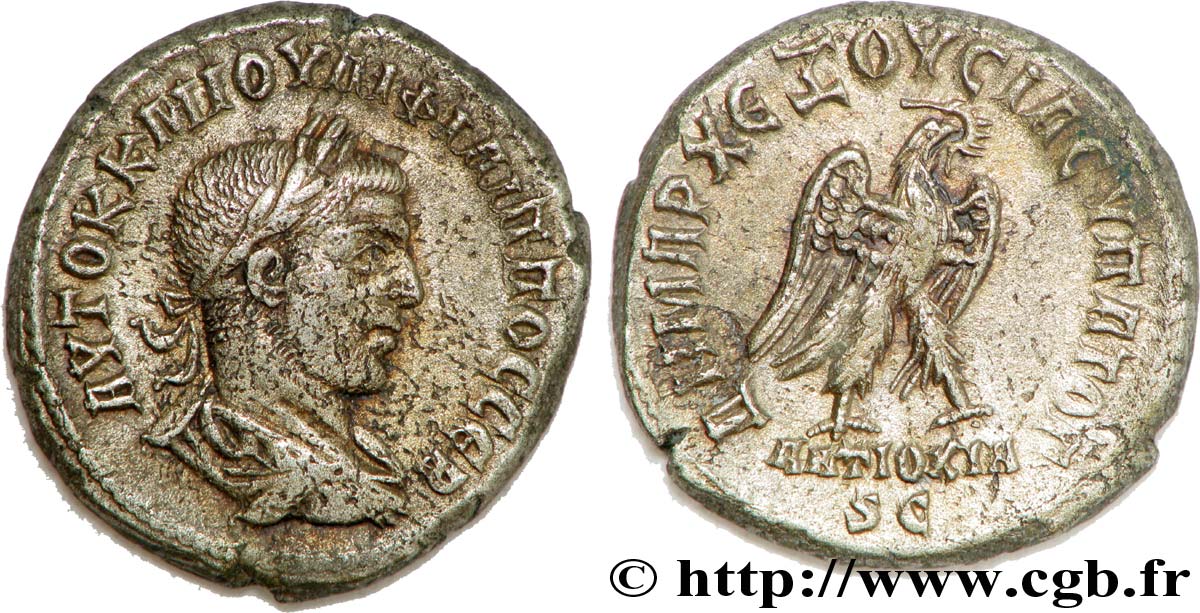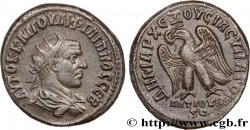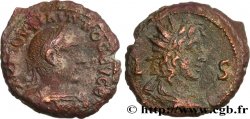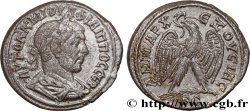bpv_154023 - PHILIPPUS Tétradrachme syro-phénicien
недоступный.
Товар уже продан в нашем интернет-магазине (2013)
Цена: : 68.00 €
Товар уже продан в нашем интернет-магазине (2013)
Цена: : 68.00 €
Тип Tétradrachme syro-phénicien
Дата: 248
Монетный двор / Город: Antioche, Syrie, Séleucie et Piérie
Металл: billon
Диаметр: 28,00 mm
Ориентация осей монеты: 2 h.
Вес: 13,13 g.
Комментарии о состоянии
Frappe bien centrée sur un flan régulier, bon style et portrait réaliste, mais légère usure et surface légèrement corrodée. Il y a peut-être des traces de surfrappe mais indistinctes
Ссылки в каталоге: :
Лицевая сторона
Аверс: описание: Buste lauré, drapé et cuirassé de Philippe Ier à droite, vu de trois quarts en arrière (A*2).
Аверс: легенда: AUTOK K M IOUL FILIPPOS SEB, (Autokratoros Kaisaros Markos Ioulios Filippos Sebastos)
Аверс: перевод: (L’empereur césar Marc Jules Philippe auguste).
Обратная сторона
Реверс: легенда: ANTIOXIA / S|C À L’EXERGUE.
Реверс: Описание: Aigle debout à droite, les ailes écartées, la gauche passant derrière la patte gauche, tête à droite et queue à gauche, tenant une couronne feuillée dans son bec.
Реверс: легенда: DHMARC - EX OUSIAS UPATOG
Реверс: перевод: (Revêtu de la puissance tribunitienne / Consul pour la troisième fois / avec l’accord du Sénat d’Antioche).
Комментарий
Ce type de buste, en proportion, est de loin le plus courant de toutes ces émissions. Symboliquement, il traduit les différents pouvoirs de l’empereur, militaires (laurier, cuirasse dont on voit une ptéryge) et civils par le drapé qui peut rappeler la toge pour le citoyen. On pourrait le considérer comme un vœu pieux, celui de la paix juste et durable, mais armée...
En abordant les frappes du 3e consulat, on remarque l’absence complète de frappes datées du deuxième consulat, bien que le deuxième consulat de Philippe existe indubitablement à Rome, y compris sur les émissions monétaires. Interruption des frappes ou comput différent à Antioche qu’à Rome ? Nous penchons pour la deuxième solution, pour deux raisons.
Tout d’abord la continuité stylistique : tant pour les revers que pour les droits, il n’y a pas de rupture, alors que l’on aurait pu présumer une certaine normalisation après une interruption des frappes. De plus, celle-ci se produira effectivement pour les frappes datées du quatrième consulat avec un style d’aigle unique, suivie à la fin par une nouveauté encore plus marquante, l’introduction d’officines indiquées sur les monnaies.
Ensuite, il existe à Antioche de très nombreuses frappes datées d’un quatrième consulat de Philippe l’Arabe dont nous ne trouvons pas trace à Rome. Il est extrêmement regrettable que les quelques informations dont nous disposons sur le Sénat d’Antioche soient largement plus tardives (4e et 5e siècle) car les émissions de tétradrachmes laissent à penser que non seulement le Sénat d’Antioche manifestait son indépendance envers Rome en frappant de l’argent avec la titulature “SC / ANTIOXIA” mais encore qu’il avait son propre comput impérial sous Philippe.
L’apparition de cette exergue et la disparition de la palme sont caractéristiques des 3e et 4e consulat mais les styles des aigles ne se normaliseront qu’au 4e.
On note que les sigma sont gravés en C.
Dans la base TSP maintenue par Michel Prieur, cinquante-sept exemplaires sont maintenant répertoriés pour ce type. Notre exemplaire, qui provient de la trouvaille dite de Syrie 1930, est le 0368_046.
This type of bust, in proportion, is by far the most common of all these shows. Symbolically, it translates the different powers of the emperor, military (laurel, breastplate of which we see a pteryge) and civil by the drapery which can recall the toga for the citizen. It could be considered a pious wish, that of a just and lasting peace, but armed. . .
When approaching the strikes of the 3rd consulate, we notice the complete absence of strikes dated from the second consulate, although Philip's second consulate undoubtedly existed in Rome, including on monetary issues.. Was the minting interrupted or was the calculation different in Antioch than in Rome? We are inclined to choose the second solution, for two reasons..
First of all, stylistic continuity: for both the backhands and the forehands, there is no break, whereas one might have assumed a certain standardization after an interruption in the strokes. Furthermore, this will actually occur for the strikes dated from the fourth consulate with a unique eagle style, followed at the end by an even more striking novelty, the introduction of offices indicated on the coins..
Then, in Antioch there are many strikes dated to a fourth consulate of Philip the Arab, of which we find no trace in Rome.. It is extremely regrettable that the little information we have on the Senate of Antioch is much later (4th and 5th century) because the issues of tetradrachms suggest that not only did the Senate of Antioch demonstrate its independence from Rome by minting money with the title “SC / ANTIOXIA” but also that it had its own imperial computus under Philip.
The appearance of this exergue and the disappearance of the palm are characteristic of the 3rd and 4th consulate but the styles of the eagles will not become standardized until the 4th.
Note that the sigmas are engraved in C.
In the TSP database maintained by Michel Prieur, fifty-seven examples are now listed for this type. Our example, which comes from the so-called 1930 Syria find, is 0368_046
En abordant les frappes du 3e consulat, on remarque l’absence complète de frappes datées du deuxième consulat, bien que le deuxième consulat de Philippe existe indubitablement à Rome, y compris sur les émissions monétaires. Interruption des frappes ou comput différent à Antioche qu’à Rome ? Nous penchons pour la deuxième solution, pour deux raisons.
Tout d’abord la continuité stylistique : tant pour les revers que pour les droits, il n’y a pas de rupture, alors que l’on aurait pu présumer une certaine normalisation après une interruption des frappes. De plus, celle-ci se produira effectivement pour les frappes datées du quatrième consulat avec un style d’aigle unique, suivie à la fin par une nouveauté encore plus marquante, l’introduction d’officines indiquées sur les monnaies.
Ensuite, il existe à Antioche de très nombreuses frappes datées d’un quatrième consulat de Philippe l’Arabe dont nous ne trouvons pas trace à Rome. Il est extrêmement regrettable que les quelques informations dont nous disposons sur le Sénat d’Antioche soient largement plus tardives (4e et 5e siècle) car les émissions de tétradrachmes laissent à penser que non seulement le Sénat d’Antioche manifestait son indépendance envers Rome en frappant de l’argent avec la titulature “SC / ANTIOXIA” mais encore qu’il avait son propre comput impérial sous Philippe.
L’apparition de cette exergue et la disparition de la palme sont caractéristiques des 3e et 4e consulat mais les styles des aigles ne se normaliseront qu’au 4e.
On note que les sigma sont gravés en C.
Dans la base TSP maintenue par Michel Prieur, cinquante-sept exemplaires sont maintenant répertoriés pour ce type. Notre exemplaire, qui provient de la trouvaille dite de Syrie 1930, est le 0368_046.
This type of bust, in proportion, is by far the most common of all these shows. Symbolically, it translates the different powers of the emperor, military (laurel, breastplate of which we see a pteryge) and civil by the drapery which can recall the toga for the citizen. It could be considered a pious wish, that of a just and lasting peace, but armed. . .
When approaching the strikes of the 3rd consulate, we notice the complete absence of strikes dated from the second consulate, although Philip's second consulate undoubtedly existed in Rome, including on monetary issues.. Was the minting interrupted or was the calculation different in Antioch than in Rome? We are inclined to choose the second solution, for two reasons..
First of all, stylistic continuity: for both the backhands and the forehands, there is no break, whereas one might have assumed a certain standardization after an interruption in the strokes. Furthermore, this will actually occur for the strikes dated from the fourth consulate with a unique eagle style, followed at the end by an even more striking novelty, the introduction of offices indicated on the coins..
Then, in Antioch there are many strikes dated to a fourth consulate of Philip the Arab, of which we find no trace in Rome.. It is extremely regrettable that the little information we have on the Senate of Antioch is much later (4th and 5th century) because the issues of tetradrachms suggest that not only did the Senate of Antioch demonstrate its independence from Rome by minting money with the title “SC / ANTIOXIA” but also that it had its own imperial computus under Philip.
The appearance of this exergue and the disappearance of the palm are characteristic of the 3rd and 4th consulate but the styles of the eagles will not become standardized until the 4th.
Note that the sigmas are engraved in C.
In the TSP database maintained by Michel Prieur, fifty-seven examples are now listed for this type. Our example, which comes from the so-called 1930 Syria find, is 0368_046








 Cообщить об ошибке
Cообщить об ошибке Распечатать страницу
Распечатать страницу Отправить мой выбор
Отправить мой выбор Задать вопрос
Задать вопрос Consign / sell
Consign / sell
 Информация
Информация









